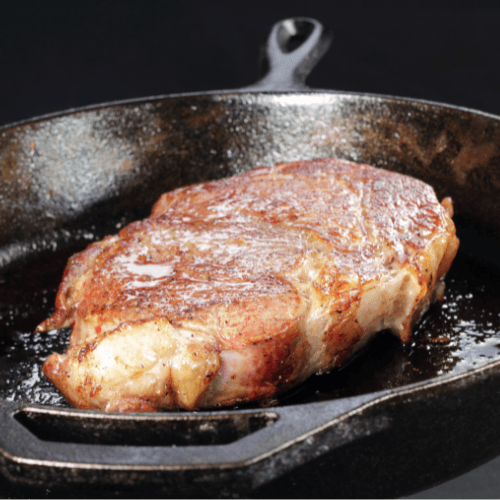
See how different pan temperatures create dramatically different results on identical pieces of meat
What You'll Master: Why proper heat control makes the difference between amateur and professional-quality searing
Time Needed: 12 minutes
You'll Need:
3 identical pieces of chicken thigh or pork chop (about 1-inch thick)
oil
paper towels
Test 1: The Cold Pan Disaster#
What You'll Notice: Starting cold creates steamed, gray meat instead of a sear The Action: Place one piece of meat in a cold pan with cold oil. Turn heat to medium and cook for 3 minutes without moving. The Discovery:
Meat releases lots of liquid immediately
No browning occurs, just gray steaming
Oil never gets hot enough to create proper reactions
Result: Tough, gray, unappetizing surface
Test 2: The Medium Heat Compromise#
What You'll Notice: Medium heat creates some browning but lacks intensity The Action: Heat second pan to medium temperature (oil just starts to shimmer). Add meat and cook for 3 minutes without moving. The Discovery:
Some browning occurs but very slowly
Meat releases moisture that fights the browning process
Light golden color develops but lacks depth
Result: Decent color but missing the deep, rich crust
Test 3: The High Heat Perfection#
What You'll Notice: Proper high heat creates immediate, dramatic browning The Action: Heat third pan until oil shimmers actively and a drop of water dances. Add meat and cook for 3 minutes without moving. The Discovery:
Immediate sizzling sound upon contact
Rapid browning starts within 30 seconds
Moisture evaporates quickly, allowing browning to continue
Result: Deep golden-brown crust with complex flavors
Test 4: The Sound and Visual Comparison#
What You'll Notice: Each temperature level produces distinct audio and visual feedback The Action: Compare all three pieces side by side, noting the color, texture, and recall the sounds each produced. The Discovery:
Cold start: Silent cooking, gray color, wet surface
Medium heat: Gentle sizzling, light brown, some moisture
High heat: Aggressive sizzling, deep brown, dry surface that will develop more flavor
What This Means for Your Cooking#
You've just discovered the Maillard reaction in action - the chemical process that creates the flavors and colors we associate with properly cooked meat. High heat creates:
Immediate moisture evaporation so browning can begin
Complex flavor compounds through proper chemical reactions
Professional-looking results that taste as good as they look
Now you understand why preheating matters and why patient heat control separates great cooks from those who just follow recipes. The dramatic visual difference shows you exactly what "proper searing temperature" accomplishes.